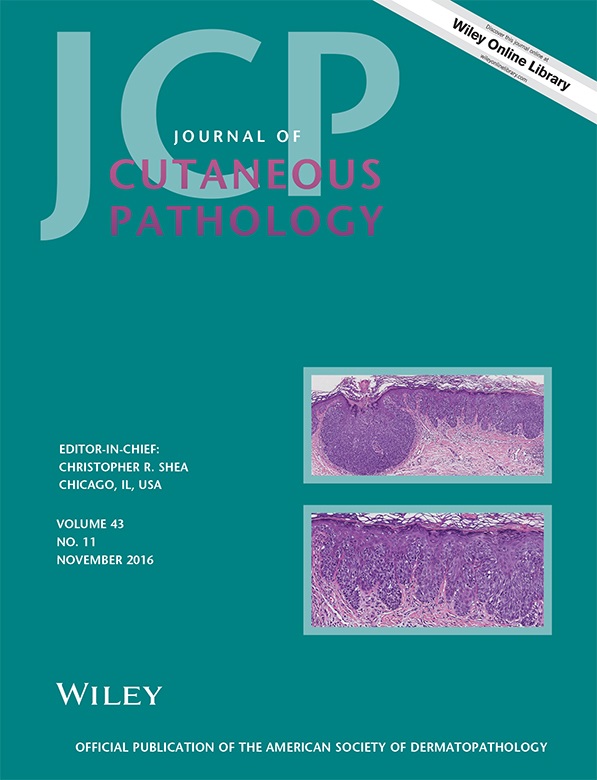CD30+ lymphoproliferative disorder with spindle-cell morphology
Kathryn J. Martires
The Ronald O. Perelman Department of Dermatology, New York University School of Medicine, New York, NY, USA
Search for more papers by this authorBrandon E. Cohen
Department of Dermatology, New York University, School of Medicine, New York, NY, USA
Search for more papers by this authorCorresponding Author
David S. Cassarino
Department of Pathology, Kaiser Permanente Los Angeles Medical Center, Los Angeles, CA, USA
David S. Cassarino, MD. PhD,
Southern California Permanente Medical Group, Sunset Medical Center, Department of Pathology, 4867 Sunset Blvd, 2nd floor, Los Angeles, CA 90027 USA
Tel: +323 783 3595
Fax: +323 783 7825
e-mail: [email protected]
Search for more papers by this authorKathryn J. Martires
The Ronald O. Perelman Department of Dermatology, New York University School of Medicine, New York, NY, USA
Search for more papers by this authorBrandon E. Cohen
Department of Dermatology, New York University, School of Medicine, New York, NY, USA
Search for more papers by this authorCorresponding Author
David S. Cassarino
Department of Pathology, Kaiser Permanente Los Angeles Medical Center, Los Angeles, CA, USA
David S. Cassarino, MD. PhD,
Southern California Permanente Medical Group, Sunset Medical Center, Department of Pathology, 4867 Sunset Blvd, 2nd floor, Los Angeles, CA 90027 USA
Tel: +323 783 3595
Fax: +323 783 7825
e-mail: [email protected]
Search for more papers by this authorAbstract
Lymphomatoid papulosis (LyP) is classified as a CD30+ primary cutaneous lymphoproliferative disease. The phenotypic variability along the spectrum of CD30+ lymphoproliferative diseases is highlighted by the distinct histologic subtypes of LyP types A, B, C, and the more recently described types D, E, and F. We report the case of an elderly woman with a clinical presentation and histopathologic findings consistent with LyP, whose atypical CD30+ infiltrate uniquely demonstrated a spindle-cell morphology. To our knowledge, this is the first reported case of LyP characterized by CD30+ spindle-shaped cells, and may represent a new and distinct histologic variant of LyP.
References
- 1Willemze R, Jaffe ES, Burg G, et al. WHO-EORTC classification for cutaneous lymphomas. Blood 2005; 105: 3768.
- 2Saggini A, Gulia A, Argenyi Z, et al. A variant of lymphomatoid papulosis simulating primary cutaneous aggressive epidermotropic CD8+ cytotoxic T-cell lymphoma. Description of 9 cases. Am J Surg Pathol 2010; 34: 1168.
- 3Kempf W, Kazakov DV, Scharer L, et al. Angioinvasive lymphomatoid papulosis: a new variant simulating aggressive lymphomas. Am J Surg Pathol 2013; 37: 1.
- 4Kempf W, Kazakov DV, Baumgartner HP, Kutzner H. Follicular lymphomatoid papulosis revisited: a study of 11 cases, with new histopathological findings. J Am Acad Dermatol 2013; 68: 809.
- 5Willemze R, Beljaards RC. Spectrum of primary cutaneous CD30 (Ki-1)-positive lymphoproliferative disorders. a proposal for classification and guidelines for management and treatment. J Am Acad Dermatol 1993; 28: 973.
- 6Vergier B, Beylot-Barry M, Pulford K, et al. Statistical evaluation of diagnostic and prognostic features of CD30+ cutaneous lymphoproliferative disorders: a clinicopathologic study of 65 cases. Am J Surg Pathol 1998; 22: 1192.
- 7Kempf W, Pfaltz K, Vermeer MH, et al. EORTC, ISCL, and USCLC consensus recommendations for the treatment of primary cutaneous CD30-positive lymphoproliferative disorders: lymphomatoid papulosis and primary cutaneous anaplastic large-cell lymphoma. Blood 2011; 118: 4024.
- 8Goodlad J. The many faces of lymphomatoid papulosis. mini-symposium. Dermatopathology 2014; 20: 263.
- 9Tomaszewski MM, Lupton GP, Krishnan J, May DL. A comparison of clinical, morphological and immunohistochemical features of lymphomatoid papulosis and primary cutaneous CD30(Ki-1)-positive anaplastic large cell lymphoma. J Cutan Pathol 1995; 22: 310.
- 10Charli-Joseph Y, Cerroni L, LeBoit PE. Cutaneous spindle-cell b-cell lymphomas: most are neoplasms of follicular center cell origin. Am J Surg Pathol 2015; 39: 737.
- 11Rozati S, Kerl K, Kempf W, et al. Spindle-cell variant of primary cutaneous follicle center lymphoma spreading to the hepatobiliary tree, mimicking Klatskin tumor. J Cutan Pathol 2013; 40: 56.
- 12Wang J, Sun NC, Nozawa Y, et al. Histological and immunohistochemical characterization of extranodal diffuse large-cell lymphomas with prominent spindle cell features. Histopathology 2001; 39: 476.
- 13Gleason BC, Calder KB, Cibull TL, et al. Utility of p63 in the differential diagnosis of atypical fibroxanthoma and spindle cell squamous cell carcinoma. J Cutan Pathol 2009; 36: 543.
- 14Jaffe ES. Anaplastic large cell lymphoma: the shifting sands of diagnostic hematopathology. Mod Pathol 2001; 14: 219.
- 15Kempf W. CD30+ lymphoproliferative disorders: histopathology, differential diagnosis, new variants, and simulators. J Cutan Pathol 2006; 33(Suppl 1): 58.
- 16Kummer JA, Vermeer MH, Dukers D, Meijer CJ, Willemze R. Most primary cutaneous CD30-positive lymphoproliferative disorders have a CD4-positive cytotoxic T-cell phenotype. J Invest Dermatol 1997; 109: 636.
- 17Stein H, Foss HD, Durkop H, et al. CD30(+) anaplastic large cell lymphoma: a review of its histopathologic, genetic, and clinical features. Blood 2000; 96: 3681.
- 18Kempf W, Kazakov DV, Rutten A, et al. Primary cutaneous follicle center lymphoma with diffuse CD30 expression: a report of 4 cases of a rare variant. J Am Acad Dermatol 2014; 71: 548.
- 19Kempf W. Cutaneous CD30-positive lymphoproliferative disorders. Surg Pathol 2014; 7: 203.
10.1016/j.path.2014.02.001 Google Scholar
- 20Bassett K, Stutz N, Stenstrom ML, Wood GS, Fleming MG. Primary cutaneous sarcomatoid anaplastic large-cell lymphoma. Am J Dermatopathol 2012; 34: 301.
- 21Erpaiboon P, Mihara I, Niimura M. Lymphomatoid papulosis: clinicopathological comparative study with pityriasis lichenoides et varioliformis acuta. J Dermatol 1991; 18: 580.




